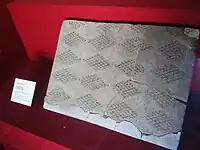34°24′57″N 108°51′45″E / 34.415817°N 108.862563°E


Xianyang Palace (咸陽宮), in (Qin) Xianyang (咸陽), now 15 km/9 miles east of modern Xianyang, Shaanxi province, was the royal palace of the state of Qin before the Chinese unification, and then the palace of the First Emperor when China was unified.
The Palace was a complex terraced building, and had elaborate murals inside.[1] Three sites were discovered (Xianyang Palace No.1, Xianyang Palace No.2, Xianyang Palace No.3).[2]
It was burnt down by Xiang Yu after the fall of the Qin dynasty.
In replacement of the Xianyang Palace, the First Emperor Qin Shihuang started to build a second palace, the Epang Palace (阿房宮 - probable meaning: "The Palace on the Hill"), 20 km/12 miles south of (Qin) Xianyang (咸陽), now 15 km/9 miles west of Xi'an (西安). It may not have been completed at the fall of the Qin Dynasty.
.jpg.webp) Bronze swords (Jian), Qin Palace
Bronze swords (Jian), Qin Palace Hollow brick with geometric design Excavated from the Site of Xianyang Palace I
Hollow brick with geometric design Excavated from the Site of Xianyang Palace I.jpg.webp) Bronze Door Knocker, Xianyang Palace I
Bronze Door Knocker, Xianyang Palace I.jpg.webp) Eaves tile with cicada design, excavated from the site of Xianyang Palace I
Eaves tile with cicada design, excavated from the site of Xianyang Palace I Square brick with bhomboid design, excavated from the site of Xianyang Palace I
Square brick with bhomboid design, excavated from the site of Xianyang Palace I A Hollow Brick with Dragon Design Excavated from the Site of Xianyang Palace I
A Hollow Brick with Dragon Design Excavated from the Site of Xianyang Palace I Drain pipes from the site
Drain pipes from the site
References
- ↑ History of Humanity: From the Seventh Century B.C. to the Seventh Century A.D. UNESCO Publishing. 31 December 1996. p. 102. ISBN 978-92-3-102812-0.
(Xianyang Palace No.1) excavated in the dynasty's capital was a complex terrace building with elaborate murals inside.
- ↑ Chang, Kwang-chih; Xu, Pingfang; Lu, Liancheng; Pingfang, Xu; Wangping, Shao; Zhongpei, Zhang; Renxiang, Wang (1 January 2005). The Formation of Chinese Civilization: An Archaeological Perspective. Yale University Press. p. 258. ISBN 978-0-300-09382-7.